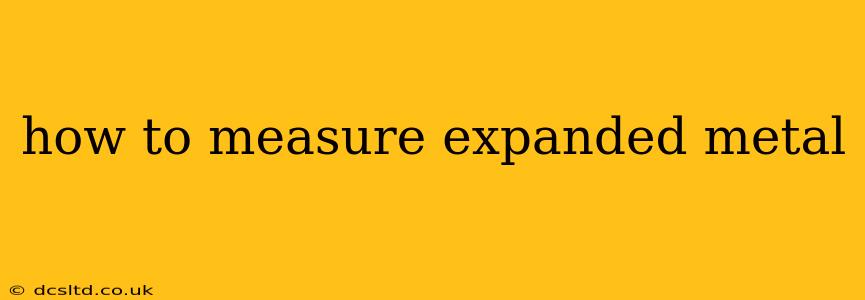Expanded metal, a versatile material used in various applications from construction to decorative arts, requires accurate measurement for successful project planning and execution. Understanding how to measure expanded metal correctly is crucial to avoid costly mistakes and ensure a perfect fit. This guide will cover the essential techniques and considerations for accurate measurements.
What are the Key Dimensions of Expanded Metal?
Before diving into measurement techniques, it's important to understand the key dimensions involved:
- Overall Width: This refers to the total width of the expanded metal sheet.
- Overall Length: This is the total length of the expanded metal sheet.
- Sheet Thickness: This is the thickness of the original metal sheet before expansion. It significantly impacts the metal's strength and rigidity. Note that expanded metal is thinner than the original sheet after the expansion process.
- Expanded Metal Width: This is the width of the metal after expansion. It's usually less than the overall width, and the difference is accounted for by the stretching during the manufacturing process.
- Expanded Metal Length: Similar to width, this is the length after expansion. It is also typically smaller than the overall length.
- Mesh Size (Opening Size): This refers to the size of the diamond-shaped openings in the expanded metal. It's usually expressed as the size of the diagonal of the diamond, or sometimes as the length and width of the diamond.
- Strand Width (Wire Diameter): This is the width of the metal strands that form the mesh. Understanding this is crucial for calculating the metal's strength and weight.
It's important to note that these dimensions aren't always explicitly provided by every supplier; some may only offer overall dimensions. Clarifying these dimensions with your supplier is critical.
How to Measure Expanded Metal Width and Length
Measuring the overall width and length is straightforward: use a standard measuring tape to measure from edge to edge of the sheet. However, remember that the expanded width and length will be smaller than the overall dimensions, and this difference can be significant depending on the expansion ratio. Always clarify which dimensions the supplier is providing.
How to Determine Expanded Metal Mesh Size
The mesh size is usually provided by the manufacturer. However, you can measure it yourself if you need to verify:
- Choose a Representative Area: Select a section of the expanded metal free from distortions or damage.
- Measure a Single Opening: Use calipers or a precise ruler to carefully measure the diagonal or the width and length of a single diamond-shaped opening. This gives you the mesh size.
How to Determine Expanded Metal Sheet Thickness
The sheet thickness, the thickness of the metal before expansion, needs to be specified by the manufacturer or supplier. You cannot accurately determine this by measuring the expanded metal itself. This information is crucial for calculating the overall strength and weight of the sheet.
What is the Importance of Accurate Measurement?
Inaccurate measurements can lead to several problems:
- Insufficient Material: Underestimating the required amount could lead to project delays and increased costs.
- Material Waste: Overestimating the required amount results in unnecessary expenses.
- Poor Fit: Incorrect measurements result in an improperly sized piece, making installation difficult or impossible.
How to Account for Expansion and Contraction (due to temperature):
While the manufacturing process creates the expansion, the metal itself can still experience thermal expansion and contraction. This is especially relevant for outdoor applications or large projects. It's essential to consult engineering resources or the metal supplier to account for these variations, especially when using expanded metal in significant projects.
What is the best way to determine the weight of expanded metal?
The weight of expanded metal depends heavily on its thickness, mesh size, and the type of metal used. The most accurate way to determine the weight is by consulting the manufacturer's specifications or contacting the supplier directly. They can provide weight per square foot or meter based on the exact material and dimensions you require.
By carefully considering and measuring all these aspects, you can ensure accurate estimations and a successful project. Remember, always double-check your measurements and clarify any ambiguities with your supplier. Precise measurement is key to successful expanded metal application.
